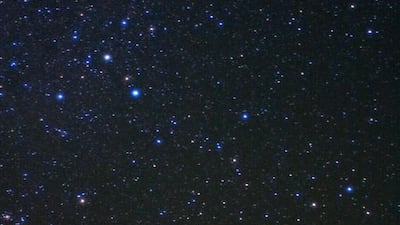At this time of year, much as their ancestors have done for hundreds of years before them, natives of the Arabian Peninsula can be seen looking to the skies, seeking a very special star.
The Suhail star (Canopus) has just become visible and can be found due south in the early hours before sunrise. The second-brightest star in the night sky after Sirius, it’s believed to signal the end of the summer heat and a return to more moderate weather.
“It is actually the other way around, where because of better weather, the Suhail star becomes more visible,” explains professor Hasan Al Naboodah, an Emirati historian and dean of the College of Humanities and Social Sciences at the UAE University in Al Ain. “And so the ancient Arabs used this observation to begin a calendar that has proven to be useful and consistent over time for predicting the weather for farming and travel.”
This near-forgotten almanac is Al Drour, one of the Gulf’s oldest calendars – the legendary Arab navigator Ahmad ibn Majid (believed to have been born in either Julfar, Ras Al Khaimah, or Sohar, Oman) made reference to it more than 500 years ago.
Al Drour charts four different seasons that are divided by the stars and their heliacal risings and settings. Each season is associated with certain weather cycles, as well as certain harvests, migratory patterns for birds and fish, and other information that has been key to Gulf settlers through history. They could – and still can – consult Al Drour to find out the best times to plant and harvest certain crops, to fish for specific species and plan travel and pearl-diving expeditions.
Al Drour is a 365-day calendar, with three seasons of 100 days and one of 60 days. The remaining days are known as Al Khams Al Masrouqa, or the five stolen days. The first 100 days of the calendar represent the autumn, known as Al Safri or Al Sufari (which refers to yellow of the leaves), followed by 100 days of winter, or Sheta, then 100 days of summer, or Saif. This is followed by 60 days of a really hot summer period known as Al Qaiz. The last five “stolen days” represent turbulent and unpredictable weather.
“The calendar embodies the wisdom of hundreds of years, and while today we can consult the internet and our smartphones for weather and climate changes, we can still refer to Al Drour to understand the environment around us,” Al Naboodah says.
As per the calendar, the sighting of the Suhail star means we can look forward to a break in the sweltering summer heat. “Suhail also means handsome or good looking, and it has another name, Al Basheer Al Yamani, where it is the star of the south [from Yemen] that brings bushra – good news,” Al Naboodah says. “This star is an omen of better times, better weather, new harvests and the beginning of a new cycle. It also signals the beginning of travel, where in the past, nomadic caravans would begin to plan their trips.”
This change in weather patterns also brings southern winds, as well as the possibility of rain. “There is a saying that when the Suhail appears, be wary of flash floods, and so people living near valleys should be taking extra precautions,” he says.
There are several myths relating to this star, the historian explains. One goes that the handsome Suhail (or Canopus) seduced and married the maiden Al Jauzah (Orion), and then in a fit of jealousy, murdered her. He then had to flee, chased by Sirius, the dog star, all the way to the south, where he remains to this day, all alone. In another version, Suhail tried to woo Al Jauzah, who not only refused his advances, but kicked him all the way to the southern heavens.
rghazal@thenational.ae
Follow us @LifeNationalUAE
Follow us on Facebook for discussions, entertainment, reviews, wellness and news.

